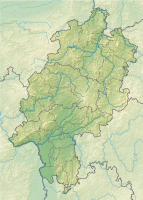Sealing hall
| Sealing hall | |||
|---|---|---|---|
| General information about the mine | |||
| Mining technology | Civil engineering | ||
| Funding / total | approx. 10,000 t | ||
| Information about the mining company | |||
| Start of operation | circa 1848 | ||
| End of operation | circa 1912 | ||
| Funded raw materials | |||
| Degradation of | Eisenstein | ||
| Greatest depth | 50 m | ||
| Geographical location | |||
| Coordinates | 50 ° 36 '34.4 " N , 8 ° 33' 1" E | ||
|
|||
| local community | Lahnau | ||
| country | State of Hesse | ||
| Country | Germany | ||
| District | Wetzlar mountain area | ||
The Dichthall mine was an iron ore mine near Waldgirmes (municipality of Lahnau ) in the Lahn-Dill district . The pit was between Waldgirmes and Königsberg (Biebertal) in a wooded area in the Schwarzbachtal northwest of the L3286 road.
history
The Hofadvokat Briel Giessen received a on July 25, 1841 mining bill and got the mine on August 14, 1848 Eisenstein Awarded . Around 1879 ownership passed to the court advocate Wendig zu Gießen, who handed the business over to Bergassessor Petri (trade union Cur-Cöln zu Gießen) in 1905. After the company was transferred to Krupp in 1916, it has been owned by Harz-Lahn Erzbergbau AG Barbara Rohstoffsbetriebs-GmbH since 1952.
In the 75 acre (187,500 m²) pit field , sporadic mining and test work were carried out from 1848 onwards . For this purpose, two test shafts with a depth of 10 m were created. Intensive operation took place around 1905. Around 1908 a steam locomotive was used to transport water and ore. Around 1910, two production wells have a depth of 50 m at brought and applied 10 more test wells with a depth of 10 m. In 1911 the facility was expanded to include a conveyor track and an ore storage area.
Operations ceased in 1912.
See also
Individual evidence
- ↑ Ralf Stahl, hiking guide through the historical mining of the community Waldgirmes
